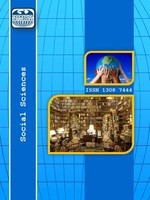EKONOMİK KRİZLERİN İMKB`DE TEMETTÜ POLİTİKALARIÜZERİNE ETKİSİ
Tasarruflarını sermaye piyasalarında değerlendiren yatırımcılar açısından sermaye kazancı ve temettü getirisi olmak üzere, iki tür kazanç söz konusudur. Ortaklık ilişkisinden doğan bir hak olan temettü getirisi firma ortaklığının, firmanın elde ettiği net kardan pay alma hakkıdır. Firma açısından temettü politikası öz kaynak yapısının belirleyicisi olması, yatırımcı açısından ise beklenen bir kazanç niteliği taşıması nedeniyle oldukça önemlidir. Çalışmanın amacı krizlerin İstanbul Menkul Kıymetler Borsası`nda işlem gören firmaların temettü politikalarını nasıl etkilediğini incelemektir. Bu amaç doğrultusunda, öncelikle Lintner modeli (1956) temel alınarak, İstanbul Menkul Kıymetler Borsası`nda (İMKB) 1986-2010 dönemleri için nakit temettü ödemesi yapan firmaların düzeltme hızları ve hedeflenen temettü ödeme oranlarının değişimi incelenmiş; daha sonra ise krizlerin temettü politikaları üzerindeki etkisi Chow Testi ile analiz edilmiştir. Elde edilen sonuçlara göre, 1986-2010 dönemlerinde sabit bir temettü ödeme oranının olmadığı ve kriz etkileri ile yapısal kırılmalara uğrayan bir temettü ödeme sisteminin varlığı tespit edilmiştir. Ayrıca Chow Testi sonuçlarında analize konu olan dönemlerde, piyasada 1998 – 2001 yıllarının ayırdığı iki temel temettü politikasının varlığı gözlemlenmiştir.
Anahtar Kelimeler:
Temettü Politikaları, Kriz Temettü, Chow Testi, Temettü Düzeltme Hızı, Hedeflenen Temettü Ödeme Oranı,
THE EFFECT OF ECONOMIC CRISIS ON DIVIDEND POLICY OF ISE COMPANIES
Dividend policy decisions which are major determinant of firm capital structure can affect the financial structure of the company. Capital gains and dividend payments are two types of return for investors in capital market. The shareholders have the right to claim dividend payments over a firm`s profit. On the other hand, in terms of financing decisions dividend policy can be considered as cost of capital for a firm. Hence, dividend policy is major issue for both investors and companies. The purpose of this study is to analyze the affect of economic crisis over dividend policy in Istanbul Stock Exchange (ISE). The analyses consist of two steps. The first step involves the estimation of payout ratio and speed of adjustment coefficient defined in Lintner`s model (1956); and the second step investigates the structural breaks on market`s dividend policy via Chow Test. The results show that there is not a stable dividend payout ratio over the period 1986-2010. Furthermore, economic crisis during 1998 – 2001 period resulted a major structural change on dividend policy in ISE.
Keywords:
Dividend policy, Dividend – crisis relationship, Chow test, Payout ratio, Speed of adjustment coefficient, ,
___
- Adaoglu, C., (2000). Instability in the Dividend Policy of the Istanbul Stock Exchange (ISE) Corporations: Evidence from an Emerging Market, Emerging Markets Review, 1, pp.252-270.
- Akgüç, Ö., (1998). Finansal Yönetim, 7. Baskı, Avcıol Basım Yayın, İstanbul.
- Baker, H.K., (1988). The Relationship Between Industry Classification and Dividend Policy, Southern Bussiness Review, 14, No: 1, pp.1-8.
- Baker, H.K. and Powell, G.E., (2000). Determinants of Corporate Dividend Policy: A Survey of NYSE Firms, Financial Practice and Education, Spring/Summer, pp. 29-40.
- Black, F., (1976). The Dividend Puzzle, Journal of Portfolio Management, Winter, No. 2, pp.5-8.
- Brenpan, M.J., (1970). Investor Taxes, Market Equilibrium and Corporation Finance, Unpublisbed Pb.D. Dissertation (Massacbusetts Institute of Tecbnology, Cambridge, Mass.).
- Brigham, F. and Houston, F., (2006). Fundamentals of Financial Management, 10th Edition, ISBN: 9780324178296
- Fama, E.F., (1974). The Empirical Relationships between the Dividend and Investment Decisions of Firms, The American Economic Review, Vol. 64, No. 3, pp. 304-318.
- Fama, E.F. and French, K.R., (2001). Disappearing Dividends: Changing Firm Characteristics or Lower Propensity to Pay?, Journal of Financial Economics 60, pp.3-44.
- Frankfurter, G. M., Wood B. G., (1997). The Evolution of Corporate Dividend Policy, Journal of Financial Education 23:1, pp.16–32.
- Gordon, M.J., (1963). Optimal Investment and Financing Policy, The Journal of Finance, Vol. 18, No. 2, pp. 264-272.
- Ho, H., (2003). Dividend Policies in Australia and Japan, International Advances in Economic Research 9 (2), pp.91-100. Kadılar, C., (2005), SPSS Uygulamalı Zaman Serileri Analizine Giriş, Bizim Büro Basımevi, Ankara.
- Lease, R.C., Kose, J., Avner, K., Uri, L., and Oded, H.S., (2000). Dividend Policy: Its Impact on Firm Value, Boston, Harvard Business School Press.
- Lintner, J., (1956). Distribution of Incomes of Corporations Among Dividends, Retained Earnings, and Taxes, The American Economic Review, Vol. 46, No. 2, pp. 97-113.
- Lintner, J., (1962). Dividends, Earnings, Leverage, Stock Prices and the Supply of Capital to Corporations, The Review of Economics and Statistics, Vol. 44, No. 3, pp.243-269.
- Michael, A., (1979). Industry Influence on Dividend Policy, Financial Management, 8, No. 3, pp. 22-26.
- Miller, M.H. and Modigliani, F., (1961). Dividend Policy, Growth, and the Valuation of Shares, The Journal of Business, Vol. 34, No. 4, pp. 411-433.
- Özer, H., (2004), Nitel Değişkenli Ekonometrik Modeller: Teori ve Bir Uygulama, Nobel Yayın, Ankara.
- Walter, J.E., (1953). Dividend Policies and Common Stock Prices, Vol. 8, No. 3, pp. 283-297
- Yılmaz, M.K., (2003). Hisse Senetleri İMKB’de İşlem Gören Firmaların Temettü Politikaları Üzerine Bir Analiz: Nakit Temettü – Sektör Davranışları İlişkisi, İMKB Dergisi, Cilt:7, Sayı:25-26, ss.17-40.
- Başlangıç: 2009
- Yayıncı: Cevdet Emin EKİNCİ
Sayıdaki Diğer Makaleler
EKONOMİK KRİZLERİN İMKB`DE TEMETTÜ POLİTİKALARIÜZERİNE ETKİSİ
Hakan Aygören, Hafize Meder Çakır, Umut Uyar
MALATYA KENT HALKININ DIŞ MEKÃÆ'aÅ¡N BİTKİ TERCİHLERİNİN BELİRLENMESİ ÜZERİNE BİR ARAŞTIRMA
Fürüzan Aslan, Latif Gürkan Kaya, Bülent Yılmaz, Atilla ATİK
YİYECEK İÇECEK İŞLETMELERİNDE MUTFAK TASARIMINDA DİKKAT EDİLMESİ GEREKEN FAKTÖRLER
Osmanlılar Dönemi Mimari Anıtların Fonksiyon Değiştirmesine iki Örnek;
